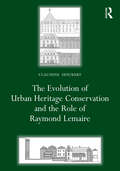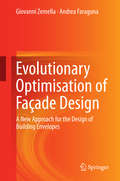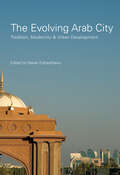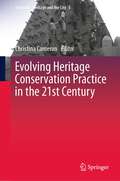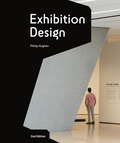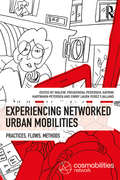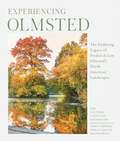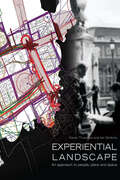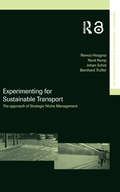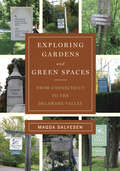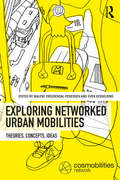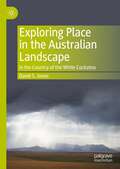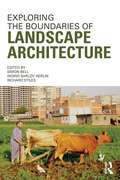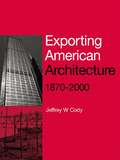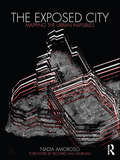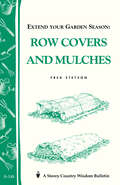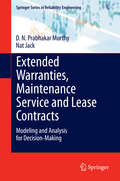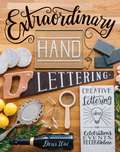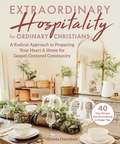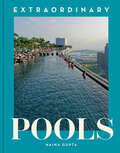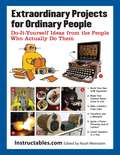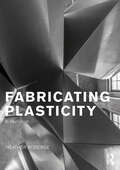- Table View
- List View
The Evolution of Urban Heritage Conservation and the Role of Raymond Lemaire (ISSN)
by Claudine HoubartThe 1960s and 1970s saw a marked change in the approach to built heritage conservation. From a focus on the preservation of individual buildings, attention turned to the conservation, regeneration, and reuse of entire historic districts. A key player in this process was the Belgian art and architecture historian Raymond Lemaire (1921–1997), yet beyond those in conservation circles few people know of his work and influence or even recognize his name.In this book, Claudine Houbart traces how the change came about and the role played by Lemaire. She describes his work and influence and in so doing provides a history of urban conservation over the last four decades of the twentieth century and beyond. The first chapter summarizes Lemaire’s background from his training during the Second World War and his work as a Monuments Man immediately after the war, to his role in the drafting of the Venice Charter and his appointment as Secretary General of ICOMOS (International Council on Monuments and Sites). The next chapter describes the rehabilitation of Great Beguinage in Louvain. Now a UNESCO World Heritage Site, the project was directed by Lemaire and is a perfect example of the restoration of an entire district. The following chapter provides case studies of his work in Brussels, demonstrating his methodology in action. The final chapter discusses the transposition of the model of the historic city to urban projects and summarizes Lemaire’s influence on heritage conservation today, particularly integrated conservation. His participation in drafting key conservation documents sponsored by the Council of Europe, UNESCO and ICOMOS, and his desire to revise the Venice Charter are discussed. The book’s conclusion reflects on what has gone before, ending aptly with Lemaire’s own words ‘the past, properly understood, is one of the references for judging the value of today and tomorrow’.
Evolutionary Optimisation of Façade Design
by Giovanni Zemella Andrea FaragunaOptimization techniques offer immense potential for the improvement of performance-driven design, since they allow the adoption of an holistic approach. This can lead to great advantages: optimal design solutions can be properly identified only if all criteria are considered at the same time, rather than separately. There are two barriers which obstruct optimization from being applied to building design: a technological barrier (applying the algorithms is not easy and can be quite time-consuming) and a cultural one (architects and engineers are required to change their perspectives as the design process has to be handled in a new way). This book explores these barriers from the perspective of both engineers and architects, and proposes a change in the attitudes of these two "actors": an engineer and an architect develop a dialog which helps them understand each other's perspective; in this way they find how they must both make a step forward.
The Evolving Arab City: Tradition, Modernity and Urban Development (Planning, History and Environment Series)
by Yasser ElsheshtawyToday cities of the Arab world are subject to many of the same problems as other world cities, yet too often they are ignored in studies of urbanisation. This collection reveals the contrasts and similarities between older, traditional Arab cities and the newer oil-stimulated cities of the Gulf in their search for development and a place in the world order. The eight cities which form the core of the book – Rabat, Amman, Beirut, Kuwait, Manama, Doha, Abu Dhabi and Riyadh – provide a unique insight into today’s Middle Eastern city. Winner of The International Planning History Society (IPHS) Book Prize.
Evolving Heritage Conservation Practice in the 21st Century (Creativity, Heritage and the City #5)
by Christina CameronThis book focuses on current trends in cultural heritage conservation and their influence on heritage practice. Seen through the lenses of World Heritage, historic urban landscapes, heritage tourism, climate change or the nature/culture nexus, these challenges call for innovative approaches to protect and conserve our heritage places. The book brings together the voices of different stakeholders in the heritage conservation process, ranging from scholars, site managers and government officials to young professionals and students.
Exhibition Design Second Edition: An Introduction
by Philip HughesExhibition Design describes the skills needed to become an exhibition designer, including: developing a brief and working with clients; design principles for graphics, circulation, lighting, and accessibility; presenting ideas to clients; and the practicalities of production. A wealth of visual material includes photographs of completed exhibitions by world-renowned designers, concept drawings, computer renderings, charts and tables of information – all for a wide range of exhibitions around the world, permanent and temporary, including museums and galleries, visitor centres, brand experiences, festivals, and trade fairs. This second edition includes new examples, updated information on the latest digital technology, and expanded coverage of interactives and sound and film.
Exhibition Design Second Edition: An Introduction
by Philip HughesExhibition Design describes the skills needed to become an exhibition designer, including: developing a brief and working with clients; design principles for graphics, circulation, lighting, and accessibility; presenting ideas to clients; and the practicalities of production. A wealth of visual material includes photographs of completed exhibitions by world-renowned designers, concept drawings, computer renderings, charts and tables of information – all for a wide range of exhibitions around the world, permanent and temporary, including museums and galleries, visitor centres, brand experiences, festivals, and trade fairs. This second edition includes new examples, updated information on the latest digital technology, and expanded coverage of interactives and sound and film.
Exotic Flowers for Artists and Craftspeople (Dover Pictorial Archive)
by Yuko GreenThe lavish colors and exotic beauty of tropical flowers have long made them favorite subjects of artists and craftspeople. This splendid sourcebook of copyright-free illustrations offers workers in many arts and crafts a marvelous sampling of lovely blossoms from rain forests, jungles, and tropical regions around the world. Depicting blossoms from trees, shrubs, vines, and ornamental herbs, 135 accurately detailed drawings depict a host of superb specimens, as varied in size and shape as they are in natural habitat. Included are the Indian Coral Tree, Sausage Tree, Monkeypod, Shrimp Plant, Crown Flower, Blushing Bride, Cup of Gold, Bird of Paradise, African Tulip, Angel's Trumpet, Butterfly Hibiscus, Thimbleberry, King Protea, Crown of Thorns, Passion Flower, Rattle Shaker, Orchid Tree, Rose Apple, Gardenia, Candle Bush, Pincushion, Lipstick Plant, Orange Trumpet, Spider Lily, and over 100 other flowers.All are identified by their common and scientific names as well as by regions of origin. Ideal for adding dramatic accents to embroidery projects and textile patterns, for use in woodworking, leathercraft, metalwork, and a host of other crafts, this varied collection represents a superb resource for artists, illustrators, and anyone in need of striking floral decorations.
Experiencing Networked Urban Mobilities: Practices, Flows, Methods (Networked Urban Mobilities Series)
by Malene Freudendal-Pedersen Katrine Hartmann-Petersen Emmy Laura Perez FjallandExperiencing Networked Urban Mobilities looks at the different experiences of networked urban mobilities. While the focus in the first book is on conceptual and theory-driven perspective, this second volume emphasizes the empirical investigation of networked urban mobilities. This book is a resource for researchers interested in the field to gain easy access and overviews of different themes and approaches represented in the mobilities paradigm.
Experiencing Olmsted: The Enduring Legacy of Frederick Law Olmsted's North American Landscapes
by The Cultural Landscape Foundation Charles Birnbaum Dena Tasse-Winter Arleyn Levee200 Iconic Landscapes That Define North America Frederick Law Olmsted is the father of American landscape architecture. His firm, and the successor firms that sprung from it, worked through the nineteenth and twentieth centuries to shape some of our most beloved green spaces, including national, state, and city parks, suburban neighborhoods, and academic campuses. He is most famous for creating New York&’s Central and Prospect Parks, Stanford University&’s campus, and the Capitol Grounds. What is less known and surprising about his legacy is that he worked widely across North America. By highlighting 200 iconic landscapes, many of which are still open to the public today, Experiencing Olmsted brings a fresh approach to the firms&’ work and philosophy. It highlights not only grand city parks, but also other public venues born out of a desire for social equity. Olmsted was an early voice for parks as democratic spaces that could be reached on foot by a large percentage of any city&’s populace. He viewed parks as restorative places—what he termed &“the lungs of a city.&” Brimming with contemporary and archival photography as well as original drawings and plans, this truly remarkable record brings these places to vivid life.
Experiential Landscape: An Approach to People, Place and Space
by Kevin Thwaites Ian SimkinsExperiential Landscape offers new ways of looking at the relationship between people and the outdoor open spaces they use in their everyday lives. The book takes a holistic view of the relationship between humans and their environment, integrating experiential and spatial dimensions of the outdoors, and exploring the theory and application of environmental design disciplines, most notably landscape architecture and urban design. The book explores specific settings in which an experiential approach has been applied, setting out a vocabulary and methods of application, and offers new readings of experiential characteristics in site analysis and design. Offering readers a range of accessible mapping tools and details of what participative approaches mean in practice, this is a new, innovative and practical methodology. The book provides an invaluable resource for students, academics and practitioners and anyone seeking reflective but practical guidance on how to approach outdoor place-making or the analysis and design of everyday outdoor places.
Experimenting for Sustainable Transport: The Approach of Strategic Niche Management (Transport, Development and Sustainability Series)
by Johan Schot Remco Hoogma Rene Kemp Bernhard TrufferTechnological change is a central feature of modern societies and a powerful source for social change. There is an urgent task to direct these new technologies towards sustainability, but society lacks perspectives, instruments and policies to accomplish this. There is no blueprint for a sustainable future, and it is necessary to experiment with alternative paths that seem promising. Various new transport technologies promise to bring sustainability benefits. But as this book shows, important lessons are often overlooked because the experiments are not designed to challenge the basic assumptions about established patterns of transport choices. Learning how to organise the process of innovation implementation is essential if the maximum impact is to be achieved - it is here that strategic niche management offers new perspectives. The book uses a series of eight recent experiments with electric vehicles, carsharing schemes, bicycle pools and fleet management to illustrate the means by which technological change must be closely linked to social change if successful implementation is to take place. The basic divide between proponents of technological fixes and those in favour of behavioural change needs to be bridged, perhaps indicating a third way.
Exploring Gardens & Green Spaces: From Connecticut to the Delaware Valley
by Magda SalvesenAn illustrated guidebook to a rich array of 148 designed landscapes along the Northeast Corridor. Nestled all along the northeast corridor, a profusion of horticultural gems and designed landscapes beckons visitors, from celebrated formal parks, estates, and arboretums to less familiar--and often hard to find--gardens. This unique guidebook features 148 of them, providing readers with an incomparable resource for locating and exploring the region's green spaces--many with historic homes at their center. Whether large, sumptuous, and impressively maintained, or modest in size, budget, and staff, all have distinctive historical, artistic, and horticultural offerings that make them well worth a trip. Mt. Cuba Center and Winterthur in Delaware, Longwood Gardens in southeastern Pennsylvania, Grounds for Sculpture and the Leonard J. Buck Garden in New Jersey, the Humes Japanese Stroll Garden on Long Island, Stonecrop Gardens and Innisfree in the Hudson Valley, and Elizabeth Park and Hollister House in Connecticut are just a few of the great gardens highlighted. Featuring more than three hundred color photographs and twenty-nine maps, with a fund of practical information for each entry--including transportation, nearby eateries, and other sites of interest, Exploring Gardens and Green Spaces is a veritable tour guide at your fingertips, showcasing an array of gardens that await discovery.
Exploring Networked Urban Mobilities: Theories, Concepts, Ideas (Networked Urban Mobilities Series)
by Malene Freudendal-Pedersen Sven KesselringExploring Networked Urban Mobilities explores different conceptual and theoretical angles between social practices and urban environments, culture, infrastructures, technologies, and the politics of mobility. The book introduces the concept of networked urban mobilities and lays out a research agenda for the future of mobility studies. Each of the contributors represents a specific approach in the field and each article provides cutting-edge theoretical and conceptual reflections on the topic. Mobility here is understood as a heterogeneous phenomenon that shapes modern societies and cities by emerging in different dimensions: as physical, social, cultural, and digital mobilities.
Exploring Place in the Australian Landscape: In the Country of the White Cockatoo
by David S. JonesIncluded is a deep ethno-ecological and cross-cultural translation, that takes the reader through both the Western understanding of sense of place as well as the Australian Aboriginal understanding of Country. Both are different intellectual constructions of thoughts, values and ideologies, but which share numerous commonalities due to their archetypal meanings, feelings and values transmitted to humans.
Exploring the Boundaries of Landscape Architecture
by Simon Bell Ingrid Sarlöv Herlin Richard StilesWhat have cultural anthropologists, historical geographers, landscape ecologists and environmental artists got in common? Along with eight other disciplines, from domains as diverse as planning and design, the arts and humanities as well as the social and natural sciences, they are all fields of importance to the theory and practice of landscape architecture. In the context of the EU funded LE:NOTRE Project, carried out under the auspices of ECLAS, the European Council of Landscape Architecture Schools, international experts from a wide range of related fields were asked to reflect, each from their own perspective, on the interface between their discipline and landscape architecture. The resulting insights presented in this book represent an important contribution to the development the discipline of landscape architecture, as well as suggesting new ways in which future collaboration can help to create a greater interdisciplinary richness at a time when the awareness of the importance of the landscape is growing across a wide range of disciplines. Exploring the Boundaries of Landscape Architecture is the first systematic attempt to explore the territory at the boundaries of landscape architecture. It addresses academics, professionals and students, not just from landscape architecture but also from its neighbouring discipline, all of whom will benefit from a better understanding their areas of shared interest and the chance to develop a common language with which to converse.
Exporting American Architecture 1870-2000 (Planning, History and Environment Series)
by Jeffrey W. CodyThe export of American architecture began in the nineteenth century as a disjointed set of personal adventures and commercial initiatives. It continues today alongside the transfer of other aspects of American life and culture to most regions of the world. Jeffrey Cody explains how, why and where American architects, planners, building contractors and other actors have marketed American architecture overseas. In so doing he provides a historical perspective on the diffusion of American building technologies, architectural standards, construction methods and planning paradigms. Using previously undocumented examples and illustrations, he shows how steel-frame manufacturers shipped their products abroad enabling the erection of American-style skyscrapers worldwide by 1900 and how this phase was followed by similar initiatives by companies manufacturing concrete components.
The Exposed City: Mapping the Urban Invisibles
by Nadia AmorosoThere is a vast amount of information about a city which is invisible to the human eye – crime levels, transportation patterns, cell phone use and air quality to name just a few. If a city was able to be defined by these characteristics, what form would it take? How could it be mapped? Nadia Amoroso tackles these questions by taking statistical urban data and exploring how they could be transformed into innovative new maps. The "unseen" elements of the city are examined in groundbreaking images throughout the book, which are complemented by interviews with Winy Maas and James Corner, comments by Richard Saul Wurman, and sections by the SENSEable City Lab group and Mark Aubin, co-founder of Google Earth.
The Exquisite Book of Paper Flower Transformations: Playing with Size, Shape, and Color to Create Spectacular Paper Arrangements
by Livia Cetti&“Equips crafters with the skills for creating individual flowers and larger arrangements while providing a delightful overview on the basics of botany.&” —Publishers Weekly In The Exquisite Book of Paper Flower Transformations, artist Livia Cetti ups the ante with a host of grander and more intricate flowers and projects—more blooms, more petals, stronger stems, and bigger, bolder arrangements! Cetti will teach you how to play with size, shape, color, and texture to create twenty-five vibrant single stems in a variety of natural shapes—globes, spikes, bells, saucers, rectangles, cones, and arcs—including hydrangeas, coral charm peonies, honeysuckles, and paperwhites. Then, you&’ll use these elemental shapes to build the 15 bright, abundant arrangements, including bold wreaths, bountiful bouquets, fantastical gilded wall art, and blooming garlands. Introducing new, never-before-seen techniques for dyeing paper and creating moldable leaves and petals, this gorgeous guide is perfect for crafters of all skill levels interested in making realistic and unique home decor, gifts, accessories, and entertaining essentials. &“Unlike fresh-cut flowers, paper blooms last forever. And if you make them like floral stylist, crafter and creative director Livia Cetti, they might even be mistaken for the real thing. One of the top paper-flower artists in the U.S.&” —House & Home
Extend Your Garden Season: Storey's Country Wisdom Bulletin A-148 (Storey Country Wisdom Bulletin Ser.)
by Fred StetsonSince 1973, Storey's Country Wisdom Bulletins have offered practical, hands-on instructions designed to help readers master dozens of country living skills quickly and easily. There are now more than 170 titles in this series, and their remarkable popularity reflects the common desire of country and city dwellers alike to cultivate personal independence in everyday life.
Extended Warranties, Maintenance Service and Lease Contracts
by D.N.Prabhakar Murthy Nat JackServing to unify the existing literature on extended warranties, maintenance service contracts and lease contracts, this book also presents a unique perspective on the topic focussed on cost analysis and decision-making from the perspectives of the parties involved. Using a game theoretic approach together with mathematical modelling, results are presented in an integrated manner with key topics that require further research highlighted in order to serve as a starting point for researchers (engineers and statisticians) who are interested in doing further work in these areas. Designed to assist practitioners (managers, engineers, applied statisticians) who are involved with extended warranties, maintenance service contracts and lease contracts, the book provides them with the models and techniques needed for proper cost analysis and effective decision-making, The book is also suitable for use as a reference text in industrial engineering, applied statistics, operations research and management.
Extraordinary Hand Lettering: Creative Lettering Ideas for Celebrations, Events, Decor, & More
by Doris WaiAre you a curious hand lettering beginner or long-time enthusiast looking to take your craft to the next level? Or are you a DIY guru or event planner wishing to breathe new life into a boring gift, event signage, or party décor? Extraordinary Hand Lettering opens your eyes to the endless possibilities in the world of creative lettering, showing you how to work with types of surfaces, such as wood, glass and acrylic, chalk, and even mirrors. First, learn the simple tools and tricks of hand lettering essentials—cursive and basic typefaces, creating balance and composition, and how to draw letters, as well as secret tips on what words you should choose to spotlight or shadow. Then, discover the lettering potentials of everyday items by transforming household objects or discarded items, such as old vintage mirrors, jewelry, and furniture, into a customized gift, unique decoration, quirky art piece, or stunning signage—all with the right lettering and choice of pen, pencil, or marker. For all DIY art-and-crafters, homemakers, and small business entrepreneurs, lettering is a versatile and necessary skill that can repurpose the old into something that is new, beautiful, and functional. Finally, draw inspirations from twelve whimsical projects suited for the girlie girl, the sophisticated man, or the modern minimalist. Combine the art of lettering and upcycling crafts to bring beauty into your everyday lifestyle.
Extraordinary Hospitality for Ordinary Christians: A Radical Approach to Preparing Your Heart & Home for Gospel-Centered Community
by Victoria DuerstockPrepare your heart and home to serve not only family and friends, but neighbors and strangers too! Make any space a haven of discipleship, connection, and comfort. As Christians, we sometimes forget the power of an open door to a lost world. Using our homes to live out our faith in the true model of the Great Commission is challenging in our busy, over-scheduled lives. But having a home that is always open and available is key to living in community with others and being missional in our thinking. In this beautiful and inspiring book, wife, mom, and interior design enthusiast Victoria Duerstock offers simple and inspiring ways to prepare our hearts and homes to be open to friends, neighbors, and strangers. You don't need an immaculate or professionally decorated home to be hospitable. In fact, there is beauty in being honest with others about our lived-in spaces, and great value in being humble enough to live life together in the midst of imperfection. But it'll be a blessing to you and to your guests to create a space that reflects the beauty, peace, and joy of life in Christ. Whether you have a tiny apartment or a big old farmhouse, you can learn how to: Declutter common areasBring hygge to your guest room (or even just to your couch, if that's all you've got!)Create a peaceful, welcoming atmosphereSchedule in regular housecleaningPrepare freezer meals for no-stress last minute dinners More importantly, be encouraged to have your heart in the right place, to engage in meaningful discussion with guests, and to take time to be a "Mary" in our works-driven "Martha" culture. Allow the Holy Spirit to overflow from your heart into your homes and community as you let your guard down and invite people into your lives.
Extraordinary Pools
by Naina GuptaA visual feast of fifty wonderfully distinctive and architecturally astounding swimming pools from around the worldExtraordinary Pools is a mosaic of exceptional public and private examples of pools, reasserting the protean quality of the swimming pool as a space of activity, pleasure, and excess. Illustrated with awe-inspiring color photography, it showcases stunning examples of architecturally significant swimming pools around the world, including:Berthold Lubetkin’s modernist Penguin Pool at the London ZooThe world’s largest infinity pool at Marina Bay Sands in SingaporeThe landmark Julia Morgan-designed City Club pool in Berkeley, CaliforniaLuis Barragan's signature L-shaped pools at Cuadra San Cristobal in MexicoAnd many moreWoven throughout are essays by swimmers and architectural experts on the role swimming pools have played in shaping modern culture, from the 1932 Olympics and Mussolini’s campaign to redefine the new Italian Fascist as physically fit, disciplined, and virile to the dawn of circular backyard pools in California that became playgrounds for skateboarders during the great drought of the 1970s. With its lush imagery and lively discussion, Extraordinary Pools will dazzle recreationists and architecture enthusiasts alike.STUNNING PHOTOGRAPHY: Illustrated with full-color images throughout, Extraordinary Pools is an aspirational, covetable volume befitting any design lover's coffee table display.ENDLESSLY FASCINATING: Swimming pools are status symbols and objects of interest regardless of climate or season. Whether they are used for athletic pursuits or the simple joy of relaxing in water, found indoors or out, are kidney-shaped or Olympic-sized, pools are an enthralling source of visual and aesthetic pleasure.EXPERIENCED AUTHOR: Naina Gupta, a practicing architect who teaches at the Architectural Association of the School of Architecture in London, turns her trained eye on a dazzling array of pools to explore their visual impact and cultural significance.Perfect for:Swimmers, beach lovers, and pool enthusiastsCollectors of architecture, design, and home décor booksHost/hostess or housewarming giftArchitectural history buffsPhotography fans and armchair travelers
Extraordinary Projects for Ordinary People: Do-It-Yourself Ideas from the People Who Actually Do Them
by Instructables. Com Noah WeinsteinCollected in this volume is a best-of selection from Instructables, reproduced for the first time outside of the web format, retaining all of the charm and ingenuity that make Instructables such a popular destination for internet users looking for new and fun projects designed by real people in an easy-to-digest way. <p><p> Hundreds of Instructables are included, ranging from practical projects like making a butcher block counter top or building solar panels to fun and unique ideas for realistic werewolf costumes or transportable camping hot tubs. The difficulty of the projects ranges from beginner on up, but all are guaranteed to raise a smile or a “Why didn’t I think of that?” <p> Numerous full-color pictures accompany each project, detailing each step of the process along the way. It’s an invitation to try a few yourself, and once you’re done, see if you don’t have a couple of ideas to share at Instructables.com.
Fabricating Plasticity in Aluminum
by Heather RobergeThis book argues for the value of the material prototype as a critical site of design innovation, through a series of design and architectural case studies. Illustrated by physical objects such as chairs, columns, and building façades, these full-scale material investigations reflect their designers’ deep knowledge of material, manufacturing, and geometry. The projects do not simply express how they are made, rather their designers leverage the capacities of metal forming to exert distinctive influence on the object’s expression and performance, embracing manufacturing processes as instruments of material innovation.Organized in two parts, part one presents the material framework informing work by Arad, Newson, Heatherwick, Future Systems, Foster, OMA, Rex, Hadid and others. Seven metal forming techniques including Press Forming, Press Brake Forming, Spinning, Panel Beating, Casting, Extruding, and Superplastic Forming are presented alongside work implemented with these processes. Part two presents original design research. Thermoformed aluminum façade systems ask critical questions of The Part: Tessellation, The Mold: Tooling, The Seam, and the Finish: Post Processing, illustrating the potential of design inquiry when techniques of material production alter techniques of design. Aluminum is redefined, inheriting a plasticity which alters the intrinsic qualities of its raw production.For students and professionals in the fields of industrial design and architecture, this book presents an optimistic role for material in the design process.
